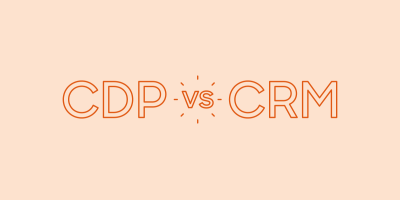Why Customer Data Infrastructure Matters

Looking around my office, I can order pretty much anything from my voice assistant, the computer I’m typing on, my mobile device — odds are you can too.
As technology has progressed, the ways customers interact with organizations have increased. So has the amount of customer data flying around. Collecting, organizing, and synthesizing all that data is the main challenge modern businesses face when it comes to creating personalized digital experiences that turn heads.
The challenge stands because customer data across an enterprise has too often been trapped in disparate systems or silos. With customer data in separate silos, using it to inform marketing strategies is more of a chore than it should be.
What organizations need is a customer data infrastructure that centralizes customer data so that it’s organized, easy to find, and universally accessible.
What is customer data infrastructure?
Customer data infrastructure (CDI) is the technology that underpins customer data collection across an organization. A single source of truth from which an organization can consolidate, govern, and activate customer data across the enterprise.
Why have CDI? Because the better organized your customer data is, the better you can accurately serve customers’ needs. And, as customer data and its sources increase, having the infrastructure in place to support it — from collection to activation — becomes a competitive advantage.
Let’s look at three key points to CDI that make it worth considering.
The importance of customer data infrastructure
Laying the foundation for customer data across an organization depends on three crucial data capabilities: integration, governance, and customer relationships. Each of these serve distinct yet allied purposes. And they all impact how your organization builds meaningful digital experiences for its customers.
Integration
There’s a lot of technology involved in customer data — technology to record it, collect it, store it, and so on. CDI ensures that these technologies play nicely with one another, unifying them into a central structure that pulls customer data into a single repository.
Customer data platforms (CDP) are great at this data synthesis. Once integrated with each data collection point, data is stored in the CDP and refined into 360-degree customer profiles. These profiles allow you to view granular data for every customer — like player-based sports stats but for customer behavior. The data integration aspect of CDI automates this process of sending information from various sources into the CDP. From there, your customer data is secure and organized, and you’re ready to learn from it.
Governance
Where integration brings organization-wide data collection and storage into tow, governance ensures proper management. Once you’ve got your customer data going into a central location like a CDP, it’s time to establish data filters. What constitutes good data versus bad data? How do you want your data stored in this central repository? What should be kept and disposed of? Who has the power to make those decisions?
CDI is your organization’s law of the land as far as data is concerned. These controls take the messy data that enters your organization and apply data collection and presentation rules that help keep it consistent.
Customer relationships
Of course, the prior two points are relatively useless if you never apply them to building customer relationships. That’s the point of having organized and meticulously maintained data: You’ve now got a good picture of who your customers are and what they’re interested in.
Applying this knowledge to marketing strategies that will improve customer experience is why you want CDI in the first place. It culminates with the relationships you build with your customers based on the data you’ve gone through the effort of collecting. You can now separate customers into different audiences, segments, interest groups, and machine learning-powered clusters and market to them in hyper-personalized ways.
And when everything is organized and well-maintained in your CDI, you can iterate on different customer data strategies to your heart’s content.
Benefits of a customer data infrastructure
Boiling down the importance of CDI is great, but knowing its tangible benefits helps put its significance into perspective.
360-degree customer view: Customer data originates from several sources. CDI ensures that data goes to one place to be organized, sorted, and structured the same across the board. Each customer record has its own viewable 360-degree profile — based on data collated from each system. The 360-degree view ensures that customer data is stored and formatted consistently, but consistency also applies to data access. Consistent collection, storage location, and structure/sorting rules give organizations a single, dependable source to work from.
Machine learning: The staggering number of customer-data records an enterprise receives is, well, staggering. A good CDI not only stores, governs, and informs strategy, it can also apply machine learning to customer data to identify commonalities and analyze records that would otherwise take years to sift through to discover patterns and insights.
Speed up, scale efforts: When your organization is no longer hunting endlessly for messy data stored all over the place, you can move more quickly to execute more campaigns, tests, segments, audience iterations, etc.
Save time and money: Centralizing customer data storage and management allows your team to abandon tools no longer needed as well as cut down on time spent searching for errant data and time spent cleaning and organizing that data when (or if) it’s found. Plus, it’ll save the sanity of teammates by avoiding organization-wide data hunting quests.
What’s next?
First things first: Have a good think about whether your customer data is well organized or haphazardly spread across the organization. Then, remember that there’s no silver bullet for customer data. Every business is different, technology moves quickly, and customer data is notoriously dynamic.
Still, a CDP is the cornerstone of CDI and a wonderful place to start curbing any customer-data chaos tripping you up. Drop us a line, and we’ll walk you through exactly how Acquia CDP can be the beginning of a masterful customer data infrastructure



